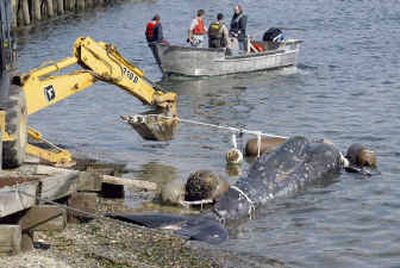Cause of gray whale’s death apparently was starvation

SEATTLE – A young female gray whale that died after swimming beneath a pier at Naval Base Kitsap near Bremerton apparently starved to death, scientists said, but more laboratory tests will help determine any underlying health problems.
Scientists gathered on a Puget Sound beach near the base on Thursday to examine the animal. The necropsy, which lasted just over four hours, confirmed researchers’ initial findings that the whale had been in poor health.
“It does not look like it had been feeding recently (based on) stomach and intestinal contents,” said John Calambokidis, a scientist with Olympia-based Cascadia Research. The nonprofit research institute performed the exam.
There were no other obvious injuries except for a few scrapes and scratches the 2½-year-old whale likely suffered when she swam among cement pilings at the base, Calambokidis said.
Additional lab results aren’t expected for several weeks.
Also present during the exam were representatives from state Fish and Wildlife and the National Marine Fisheries Service, as well as a veterinarian with the British Columbia Department of Food and Agriculture.
The whale is the third to die this season. With each, Calambokidis noted, scientists have been fortunate to recover and examine the animals within a few days of discovery.
“That’s extremely unusual,” he said. “In most cases animals have been dead many weeks, precluding the ability to look at pathology microscopically.”
The 9-ton, 30-foot whale died early Wednesday after she was spotted among pilings the night before.
It was unclear how the whale managed to enter the restricted area without anyone noticing. Calls to Navy officials Thursday were not immediately returned.
Cascadia Research biologist Erin Falcone said there is no underwater gate to block entry into the area, and the whale might not have been easily seen because she swam up during the night. Gray whales are bottom feeders who churn up the ocean floor in search of tiny sea creatures to eat.
Scientists first thought the whale might have become stuck among the pilings. Falcone said that while she wasn’t wedged in, she was unable to swim out, perhaps because of her weakened condition. Falcone added that whales aren’t good at swimming backward.
After Thursday’s necropsy, the whale was to be disposed of at sea, weighed down with concrete blocks.
West Coast grays are now making their annual migration between waters off Mexico – winter breeding grounds – and summer feeding grounds off Alaska.
About 10 gray whales are currently in Puget Sound waters, mostly around Whidbey Island, north of Seattle and Bremerton, Falcone said. On April 22, two grays were seen in Seattle’s Elliott Bay.
An average of three to five dead gray whales are found washed ashore on Washington state beaches each year.